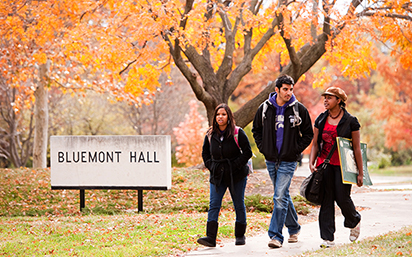


Get ready for football season: Top 10 tips for Wildcat tailgaters
On gamedays, Wildcat fans gather their friends and family, load up the grill and head to Bill Snyder Family Stadium to celebrate their purple pride and tailgate before the football game. Whether you’re a long-time tailgater or want to try tailgating for the first time, here are @K-State’s top 10 tips for creating a memorable tailgating experience. Go ’Cats!
1. Check out our Ultimate Football Guide. Find everything you need for K-State football season with the K-State Alumni Association’s Ultimate Football Guide. View maps and directions, parking information and more.
2. Share your memories. If you take photos at your tailgate and share them on social media, be sure to include #KStateAlumni. Your photo could be featured on one of the K-State Alumni Association’s social media channels.
3. Bring some tasty treats. No tailgating experience is complete without some delicious food items to enjoy. Check out the tailgate recipes section on the redesigned K-State Alumni Association website and find recipes for dishes such as bacon-wrapped jalapeno poppers, royal purple punch, Powercat poke cake and more.
4. Celebrate safely. Follow important safety tips to make sure everyone at the stadium has a great time. No objects (tables, grills, etc.) may be placed in or encroach on the Emergency Access Lane, and remember that open wood fires and campfires are prohibited. Coals should be extinguished and disposed of in the red “Hot Coals” barrels.
5. Pack plenty of water. Temperatures can still get toasty on gamedays in early fall. Make sure you bring plenty of water to stay hydrated. Even better, freeze the water bottles ahead of time and set them out right before tailgating so the water stays nice and cold as the ice melts.
6. Don’t forget the new clear bag policy. To provide a safer environment for the public and expedite guest entry into the stadium,
K-State Athletics is implementing a new bag policy this year. Bags should be clear
plastic, vinyl or PVC and not exceed 12” x 6” x 12”. You also may bring in one-gallon
clear plastic freezer bags or small clutch bags, approximately the size of a hand.
Learn more.
7. Decorate your tailgate. You’re wearing your gameday purple — don’t forget to also decorate your tailgate with fun items like a K-State flag, windsock or purple balloons (make sure all items are properly secured). Also learn how you can get an official K-State license plate for your car.
8. Grab some gear. Forget to bring your favorite K-State T-shirt? Officially licensed K-State merchandise is available for purchase on gamedays at the K-State Super Store locations on the east and west sides of the stadium, starting five hours prior to kickoff.
9. Take out the trash. Before you head home, make sure to clean up all your trash and collect your recyclable items so the tailgate area is ready to go for next time.
10. Hit the road. Want to carry on the tailgating fun at K-State away games? Find information on the Alumni Association’s pregame events throughout the season.
Ticket availability for the Missouri State (Sept. 24) and Texas (Oct. 22) games is down to scattered singles and standing room only, while the Kansas game on Nov. 26 is down to fewer than 100 contiguous seats. Wildcat 4 Packs, which include four reserved tickets, are still available for K-State’s other four home games and are only $99 for FAU (Sept. 17), $149 for Texas Tech (Oct. 8) and Kansas (Nov. 26), and $199 for Oklahoma State (Nov. 5). Tickets can be purchased through the K-State Athletic Ticket office online at www.k-statesports.com/tickets, by phone at 1-800-221-CATS or in person at the main ticket office inside Bramlage Coliseum.
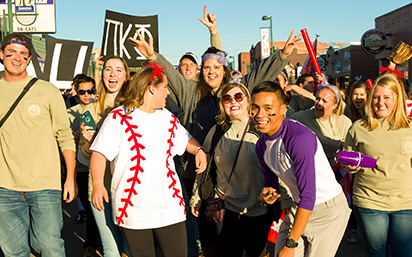
Celebrate ‘Growing Up Purple’ with K-State Homecoming 2016
Do you have a favorite K-State memory from when you were growing up? Maybe it was wearing purple and cheering on the Wildcats during a football game, sampling your favorite flavor of Call Hall ice cream or getting your picture with Willie, the K-State mascot.
Kansas State University alumni and supporters are invited to return to campus and relive those memories this fall during K-State’s 2016 All-University Homecoming week Oct. 16-22. This year’s Homecoming theme is “Growing Up Purple.”
“For more than a century, our Wildcat community has celebrated this wonderful tradition,” said Andrea Bryant Gladin ’02, director of alumni programs for the K-State Alumni Association. “We look forward to K-State fans of all ages joining us for a spirit-filled Homecoming week celebrating the K-State family, which spreads across the country and worldwide.”
All Homecoming events are open to the public. For the most updated information, visit www.k-state.com/homecoming. Here are some of the highlights planned for Homecoming week (all events and times are subject to change):
Sunday, Oct. 16
10 a.m. – Homecoming Philanthropy 5K Run/Walk, K-State Alumni Center. Students, alumni and community members may run or walk through campus in the 14th annual Homecoming 5K Run/Walk, which benefits USO Fort Riley. Register here.
5:30 p.m. – Crazy Cat Kickoff, Memorial Stadium. This series of comical games is sponsored by the K-State Association of Residence Halls.
8 p.m. – Pant the Chant, Bramlage Coliseum. Homecoming pairings perform original spirit cheers.
Tuesday, Oct. 18
10 a.m. to 5 p.m. – Paint the ’Ville, Aggieville. Check out the Aggieville windows being painted by campus organizations and Homecoming pairings.
8 p.m. – Wildcat Request Live, Bramlage Coliseum. This lip sync and dance competition showcases greek Homecoming pairings.
Thursday, Oct. 20
6 to 8 p.m. – Children’s Carnival, K-State Student Union. Open to Manhattan and surrounding communities.
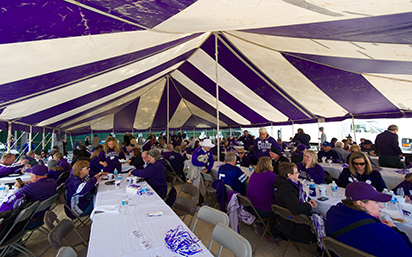 Friday, Oct. 21
Friday, Oct. 21
3 to 5:30 p.m. – Trick-or-Treat in Aggieville.
5 p.m. – Homecoming Parade. The parade route begins at Manhattan Town Center and will run along Poyntz Avenue from Third Street to 11th Street, then heads north along 11th until reaching Moro Street before snaking back south along Manhattan Avenue and concluding in City Park.
6:30 p.m. – Homecoming Pep Rally, Larry Norvell Band Shell, City Park (following the parade).
Saturday, Oct. 22
K-State vs. Texas Homecoming football game. Time TBD. Visit www.kstatesports.com for updated game times. During halftime the new Student Ambassadors will be announced, and the Homecoming Committee members will be recognized.
A pregame celebration will begin two hours prior to kickoff in Cat Town, which is located on the south side of the west parking lot at Bill Snyder Family Stadium. Menu includes barbecue brisket, pulled pork sandwiches, tossed salad, honey baked beans, potato salad, rolls with butter, cookies and brownies, beer, wine and soft drinks. Cost is $20 per adult and $15 per child (4-17 years old). RSVPs are required by Oct. 14.
K-State vs. West Virginia volleyball game. Time TBD. Visit www.kstatesports.com for updated game times.
Homecoming is a university-wide celebration coordinated by the K-State Alumni Association and sponsored by AT&T.

Photo gallery: Alumni Association hosts variety of events for students, alumni and friends in August
August was a busy month for the K-State Alumni Association, with events for alumni and friends such as Wabash CannonBall Colorado, and events for students, such as the annual Marching Band appreciation day and Wildcat Welcome Day. Find photos from these events below, and don’t forget to keep an eye on the Alumni Association calendar for upcoming events this month, such as the K-State pep rallies at noon and 5:30 p.m. Sunday, Sept. 11, at the 2016 Kansas State Fair in Hutchinson.

Abby Brookover ’05 and Erika Sauerwein ’03 have their photo taken with Willie the Wildcat during Wabash CannonBall Colorado on Aug. 12 at the Pinnacle Club in the Grand Hyatt Denver. (Photo: Altitude Arts)

At the third annual Wabash CannonBall Colorado, K-Staters enjoyed an elegant evening of socializing, dinner, dancing and raising money to support scholarship funds for Colorado students to attend K-State. (Photo: Altitude Arts)

Students line up to receive cookies, water and popsicles during the K-State Alumni Association’s annual K-State Marching Band appreciation day Aug. 18. Alumni Association staff greeted the students after a practice and helped pass out the treats. (Photo: Ashley Pauls)
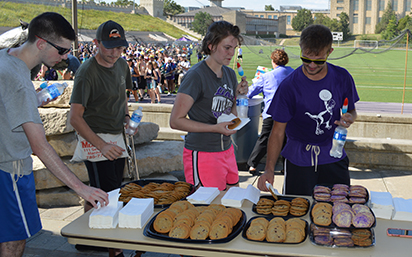
Students in the K-State Marching Band grab cookies supplied by the K-State Alumni Association after a practice session at the Memorial Stadium field. Amy Button Renz ’76, ’86, Alumni Association president and CEO, also addressed the students and thanked them for helping spread K-State pride. (Photo: Ashley Pauls)
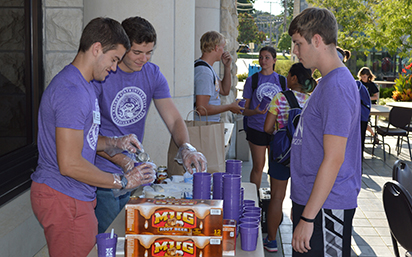
Volunteers serve up root beer floats to incoming freshmen and transfer students during Wildcat Welcome Day on Aug. 25 at the K-State Alumni Center. The free event also included music, drawings for prizes and textbooks, and information on how to get involved at K-State. (Photo: Ashley Pauls)
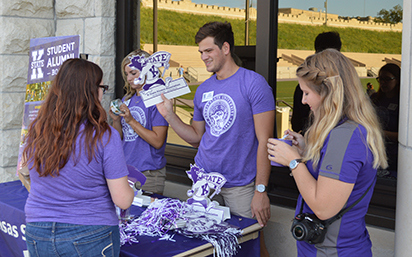
Wildcat Welcome Day is just one of the ways the K-State Alumni Association interacts with students on campus. Wildcats Forever is K-State's Student Alumni Association and includes benefits such as a membership T-shirt, discounts to local businesses, special giveaways throughout the year, and more. Give a membership as a gift. (Photo: Ashley Pauls)

Four Landon Lectures to feature experts in global security, education, animal behavior, journalism
Kansas State University’s 2016-17 Landon Lecture schedule includes a variety of public figures offering a fresh perspective on timely topics. The upcoming lineup features a CEO of a major technology and global security company; high-profile educational leaders with K-State roots; an inspiring animal behavior scientist; and a talented journalist. All four lectures are free and open to the public. K-State alumni and supporters are encouraged to attend.
Sept. 6, 2016
Wes Bush, CEO of Northrop Grumman, kicked off the 2016-17 series on Sept. 6 in McCain Auditorium. Northrop Grumman specializes in innovative systems, products and solutions in autonomous systems, cyber, command, control, communications, computers, intelligence, surveillance, reconnaissance, strike, and logistics and modernization to government and commercial customers.
Sept. 26, 2016
Up next is a higher education panel made up of K-State alumni: Lt. Gen. Robert Caslen Jr. ’89, superintendent of West Point Military Academy; David Hall ’72, president of the University of the Virgin Islands; and Bud Peterson ’75, ’77, ’80, president of Georgia Institute of Technology. They will speak at 10:30 a.m. Sept. 26 in Forum Hall in the K-State Student Union. Before taking his current post, Caslen was chief of the Office of Security Cooperation-Iraq. Hall became the fifth president of the University of the Virgin Islands in 2009 and has since worked to raise the image and position of the university, including the addition of new academic programs and the launch of new centers and institutions. Peterson serves on the National Science Board, which oversees the National Science Foundation and advises the president and Congress on national policy related to science and engineering research and education.
Nov. 29, 2016
Temple Grandin, author, world-renowned autism spokesperson, consultant to the livestock industry on animal behavior and professor of animal science at Colorado State University, will speak at 10:30 a.m. Nov. 29 in Forum Hall in the K-State Student Union. Grandin, who showed signs of autism at an early age and self-describes her unique thought process as thinking in pictures, is an accomplished livestock equipment designer and a successful animal welfare advocate. She has published several books — including New York Times best-seller Animals in Translation — and given many talks about animal welfare and the autistic brain.
April 6, 2017
Martin Baron, executive editor for the Washington Post, will speak at 10:30 a.m. April 6, 2017, in Forum Hall in the K-State Student Union. Since Baron started at the Washington Post in 2013, the paper has earned four Pulitzer Prizes, the most recent one for coverage of police shootings. From 2001-2012, he was an editor of the Boston Globe, where he participated in the paper’s investigation of the Catholic priest scandal that inspired the 2015 movie Spotlight.
Learn more about the Landon Lecture program.

Children and grandparents explore K-State and enjoy time together at Grandparents University
Although they’re not old enough yet to enroll as students at Kansas State University, a group of children got a taste of what life is like at K-State — and a chance to bond with their grandparents at the same time. This summer, 64 children and adults attended the annual Grandparents University, co-sponsored by the College of Education and the K-State Alumni Association.
Those attending Grandparents University spent three days on campus learning about K-State’s different academic and athletic programs, as well as participating in fun activities such as a scavenger hunt, bowling, swimming and sampling the delicious ice cream at Call Hall. The event kicked off with residence hall decorating and ended with a brunch at the K-State Alumni Center.
Logan Taylor, Wichita, Kansas, attended Grandparents University with Lynda Taylor ’74, Yates Center, Kansas. Logan said his favorite part of the experience was the veterinary medicine tour, since his mother is a veterinarian.
“I’m familiar with that stuff — I find it interesting,” he said.
 For Lynda, Grandparents University was special because it gave them a chance to have
fun together and explore K-State.
For Lynda, Grandparents University was special because it gave them a chance to have
fun together and explore K-State.
“We just wanted to spend some quality time together,” she said.
Grandparents University is open to children ages 8-12; anyone who would like to bring a special child in their life, such as a niece or nephew, grandchild, child or neighbor, is welcome to attend. Watch future issues of @K-State for information on next year’s Grandparents University event, or learn more about the program through the College of Education website.

Nationally recognized expert on education policy to speak at Kansas State University
Kansas State University’s College of Education has invited nationally known education policy expert Kern Alexander to speak on campus this fall as part of the Distinguished Educational Research Lecture Series.
The annual lecture series brings outstanding education research scholars to K-State to meet with faculty and students and to speak about their research. K-State alumni and supporters are welcome to attend. This year’s speaker is an Excellence Professor for the College of Education, University of Illinois, Urbana/Champaign, where he teaches courses in school law, higher education law, school finance and higher education finance. He will present “The Rise and Decline of the Public School Ideal in America: Politics, Law and Finance” at 9:15 a.m. Sept. 29 in Forum Hall at the K-State Student Union. A question and answer session will follow at 10:30 a.m. in the Flint Hills Room.
“Dr. Alexander is one of the world’s leading experts on P-12 education finance and the law of funding fairness,” said David C. Thompson, K-State College of Education professor and chair of the department of educational leadership. “His address, along with opportunity for a panel of Kansas school superintendents to engage him in Q&A, will greatly enhance insights into Kansas’ current bitter struggles between plaintiff school districts and the defendant state and should help every observer get a fresh and unbiased view of what’s really happening in Kansas today.”
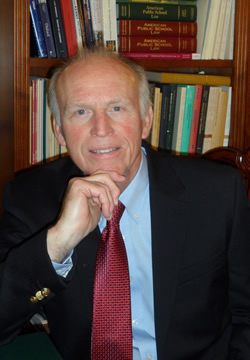 Prior to coming to the University of Illinois, Alexander served as professor of educational
administration at the University of Florida for two decades, University Distinguished
Professor at Virginia Tech for six years, and later he held the Robinson Eminent Scholar’s
Chair at the University of North Florida, Jacksonville. He also served as president
of Western Kentucky University, Bowling Green, and president of Murray State University,
where he retains the title of President Emeritus. He is the author, coauthor or editor
of 30 books.
Prior to coming to the University of Illinois, Alexander served as professor of educational
administration at the University of Florida for two decades, University Distinguished
Professor at Virginia Tech for six years, and later he held the Robinson Eminent Scholar’s
Chair at the University of North Florida, Jacksonville. He also served as president
of Western Kentucky University, Bowling Green, and president of Murray State University,
where he retains the title of President Emeritus. He is the author, coauthor or editor
of 30 books.
Thompson said Alexander will cover how school funding has developed in the United States and how Kansas historically and presently fares against these national trends and practices. Alexander has testified as an expert witness in numerous school finance court cases throughout the nation and has been instrumental in advising courts in such landmark decisions as Rose v Council for Better Education, a court case that helped set adequacy and equity funding standards in numerous states, including Kansas.
Learn more about Alexander and the Distinguished Educational Research Lecture Series.

Alumni assistance sought for communications survey
We are looking for your help! Assistant professors Sarah Riforgiate and Natalie Pennington ’10 at Kansas State University in the Department of Communication Studies are conducting research and are hoping alumni and friends (not current students) might consider taking their survey.
This research study is being conducted to better understand how communication on Facebook relates to work/life experiences. You will be asked to respond to questions about your perceptions of work and life experiences and to download a small sample of posts from your Facebook account. All information will remain anonymous. The survey should take approximately 15 to 20 minutes to complete. If you have questions you can email Natalie or Sarah (natpen@ksu.edu or sriforgi@ksu.edu). Thank you for your time and consideration!
Here’s a link to the survey: https://kstate.qualtrics.com/jfe/form/SV_3sXuPGFJVoVfQ7b

Foundation news update: $150.6 million in annual giving and Army ROTC philanthropy
Kansas State University alumni and friends give $150.6 million for fiscal year 2016
Philanthropic gifts and commitments by alumni, friends, parents, faculty, students and corporate partners of Kansas State University totaled $150.6 million in the fiscal year that ended June 30, 2016.
This level of philanthropic support marks the third most successful year in charitable giving in the more than 70-year history of the Kansas State University Foundation, and the fifth consecutive year fundraising has topped $100 million. The conclusion of fiscal year 2016 marked $882 million in total multiyear gifts and commitments toward the $1 billion goal for K-State’s Innovation and Inspiration Campaign.
K-State alumnus takes a comprehensive approach to philanthropy at K-State
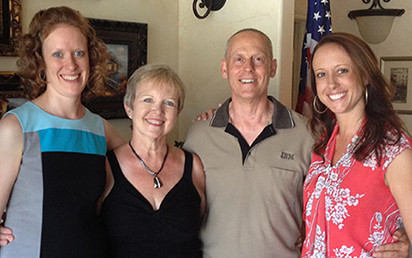 For Kansas State University graduate and retired Brig. Gen. Bruce Adams ’69, ’70,
the ROTC program was a key ingredient in his decision to give back to the university.
For Kansas State University graduate and retired Brig. Gen. Bruce Adams ’69, ’70,
the ROTC program was a key ingredient in his decision to give back to the university.
“I wouldn’t be where I am today if it hadn’t been for Kansas State University and the Army ROTC program,” Adams said. “It allowed me the opportunity to do things I would have never done in my life.”
Since making his first gift to the university decades ago, Bruce and his wife, Jan, have continued to make a lasting impact in various ways across the K-State campus. They have created a scholarship for the Army ROTC program, a scholarship for business students and a scholarship for agriculture students in remembrance of Adams’ father.
In this issue
- The good life: K-State receives high rankings in love for the college, happy students, quality of life
- Get ready for football season: Top 10 tips for Wildcat tailgaters
- Celebrate ‘Growing Up Purple’ with K-State Homecoming 2016
- Photo gallery: Alumni Association hosts variety of events for students, alumni and friends in August
- Four Landon Lectures to feature experts in global security, education, animal behavior, journalism
- Children and grandparents explore K-State and enjoy time together at Grandparents University
- Nationally recognized expert on education policy to speak at Kansas State University
- Alumni assistance sought for communications survey
- Foundation news update: $150.6 million in annual giving and Army ROTC philanthropy
College News
College of Agriculture
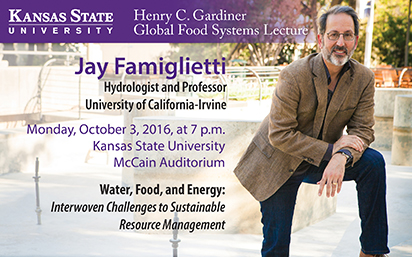
Water, climate change focus of Global Food Systems Lecture
For more than 25 years, Jay Famiglietti and his team have been researching and communicating about water and climate change — in academics, in business, in government and to the general public. He will be the featured speaker at the third annual Henry C. Gardiner Global Food Systems Lecture at 7 p.m. Oct. 3 in McCain Auditorium, Manhattan, Kansas.
Famiglietti is a hydrologist and professor of earth system science and of civil and environmental engineering at the University of California at Irvine and senior water scientist for the NASA Jet Propulsion Laboratory at the California Institute of Technology.
Before joining UCI in 2001, he was on the faculty of the Geological Sciences Department at the University of Texas at Austin, where he helped launch the program in climate and the UT Environmental Science Institute.
Using satellite technology, he has been monitoring the Ogallala Aquifer Region and other aquifers around the globe for years. The OAR serves as the main source of agricultural and public water for western Kansas and parts of seven other Great Plains states.
Because the OAR accounts for 30 percent of total crop and animal production in the U.S., the rapid decline of the aquifer level creates a problem for all of Kansas, the Great Plains and the nation.
John Floros, dean of the College of Agriculture and director of K-State Research and Extension, stressed the importance of preserving the Ogallala Aquifer Region.
“Without water, we can’t have agriculture,” Floros said. “Without agriculture, we can’t have food. Without food, we can’t sustain human life. Water, therefore, is an imperative need for the existence of human civilization and culture.”
Gardiner Angus Ranch proposed the Henry C. Gardiner Global Food Systems Lecture Series in 2013 to honor Henry C. Gardiner ’53, a visionary leader in the U.S. cattle industry who dedicated his career to improving the beef industry through the use of science and technology.
The goal of the lecture series is to present educational, thought-provoking information to the public. Previous speakers were Robert Fraley, executive vice president and chief technology officer for Monsanto, and Greg Page, executive director of Cargill.
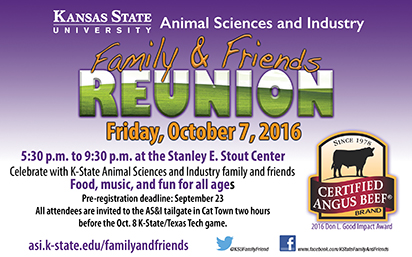
Graduates, friends invited to reconnect at department reunion
Animal Sciences and Industry graduates and friends are invited to the second annual K-State Family and Friends Reunion on Friday, Oct. 7, at the Stanley E. Stout Center in Manhattan, Kansas. An evening of reconnecting with friends, great food, music and fun is planned for this year’s event, including a special performance by the Pride of Wildcat Land band.
The department is excited to “welcome home” alumni and friends. Plan to bring the entire family for an evening of fun activities, including a Junior Wildcat Barnyard area designed for the youngest members of the department family.
A highlight this year will be a performance by the “best band in the land,” the reigning Sudler Trophy Award winner. Following the band’s performance, attendees will participate in the Wildcat Walk — a new Family and Friends tradition. The band will form an aisle for Willie the Wildcat and the kids to lead attendees into the Stout Center for the award ceremony.
The excitement will continue with the presentation of the 2016 Don L. Good Impact Award. Certified Angus Beef LLC (CAB), the world’s largest and most successful branded beef program, will receive this year’s award. With nearly four decades of leadership in the beef business, the CAB brand in fiscal year 2015 reported record sales for the ninth consecutive year, marketing 896 million pounds of product.
The award, presented by the Livestock and Meat Industry Council Inc. (LMIC), is named in honor of Don Good, former head of the K-State Department of Animal Sciences and Industry, and recognizes positive impact on the livestock and meat industry or agriculture. CAB, along with the many K-State alumni who have contributed to the brand’s success, will be recognized during the Family and Friends Reunion.
“The Livestock and Meat Industry Council is very proud to honor CAB with this year’s Don L. Good Impact award,” said Craig Good, LMIC president. “I think that it would be difficult to think of an entity that has had a more profound impact on the beef and food industry than CAB, and many people with K-State ties have had a big part in its success.”
More information about the event and registration is available online. Preregistration deadline is Sept. 23. Walk-in registration may be limited, so be sure to register today.
College of Architecture, Planning and Design
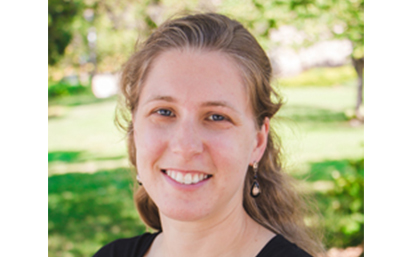
Regional and community planning student receives national fellowship
Emma Rearick, regional and community planning student, is one of 59 students across the U.S. to be honored with the 2016-2017 Dwight David Eisenhower Transportation Graduate Fellowship from the U.S. Department of Transportation. This is the second Eisenhower fellowship received by a K-State regional and community planning student. James Wood ’14, a current doctoral student at Florida State University, received the award in 2013.
The fellowship awards students pursuing degrees in transportation-related disciplines. The program advances the transportation workforce by attracting the brightest minds to the field through education, research and workforce development.
The approximate $31,900 fellowship is designated to help with tuition and provide a stipend and the opportunity to attend the Transportation Research Board annual meeting in Washington, D.C. Rearick applied for the fellowship in April by submitting a personal statement, research plan, resume, transcripts and four letters of reference.
Rearick’s research is focused on identifying and studying rural communities that are successfully reducing their dependence on personal automobiles. Her goal is to find approaches to reducing car dependence that can be shared with other rural communities.
“This fellowship will help to connect me and my research to the greater transportation planning community,” Rearick said. “Attending the Transportation Research Board annual meeting is an amazing opportunity to network and learn, and having this fellowship will encourage me to share my results with a broader audience than I might otherwise. Additionally, I think the Eisenhower Fellowship will give me the financial flexibility to take risks and pursue opportunities as they arise.”
Gregory Newmark, assistant professor of regional and community planning and Rearick’s thesis chair, received the Eisenhower Fellowship when he was in graduate school.
“The fellowship was critical to providing me the financial security to focus on learning and exploring research topics of interest to me,” Newmark said. “I hope that the fellowship will allow Emma to delve deeper into her research to be more prepared to enter and contribute to the field of transportation planning. I also hope that the fellowship will provide her a community to inspire her studies and subsequent work.”
College of Arts and Sciences
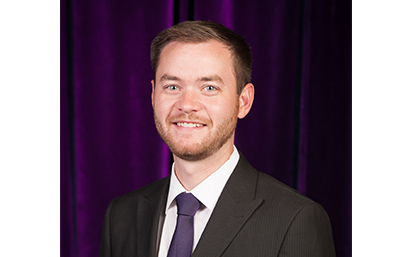
Making the show: Pinkall again part of arranging opening ceremony for Olympics
Kansas State University’s Bryan Pinkall ’07, ’10 has that Olympic touch.
The assistant professor of music once again lent his talents to the staging of an Olympic opening ceremony. This time he was part of the opening ceremony performance operations team for the 2016 Summer Olympics in Rio de Janeiro.
Pinkall was selected in late 2015 to be part of the team, joining performing arts professionals from around the world in volunteering their time and expertise to create the opening ceremony, which is one of the world’s largest artistic events.
“The details surrounding the opening ceremony are highly secretive,” Pinkall said. “On the evening of Aug. 5, a worldwide television audience of billions [was] able to witness the ceremony live from Maracanã Stadium in Rio de Janeiro. The 2016 games are the first to be hosted in South America.”
Pinkall is becoming an old hand at helping manage such large events. He was part of the Emmy-winning team behind the opening ceremony for the 2014 Winter Olympic Games in Sochi, Russia. He also helped with staging the 2015 World Meeting of Families Papal Mass in Philadelphia.
Along with teaching vocal performance at K-State’s School of Music, Theatre and Dance in the College of Arts and Sciences, Pinkall is a professional singer with the Kansas City Chorale. The group is under the direction of Charles Bruffy and won a Grammy Award in 2016 for best choral performance.
More information about Pinkall is available at bryanpinkall.com.
Joining Pinkall in Rio de Janeiro was Phillip Vardiman, director of the university’s athletic training program, who was an athletic trainer on the medical team serving the U.S. track and field team.

Physics researchers invent, patent new class of lasers
A new class of lasers developed by a team that included physics researchers at Kansas State University could help scientists measure distances to faraway targets, identify the presence of certain gases in the atmosphere and send images of the earth from space.
These energy-efficient lasers also are portable, produce light at difficult-to-reach wavelengths and have the potential to scale to high-powered versions.
The new lasers were invented by Brian Washburn and Kristan Corwin, both associate professors of physics at Kansas State University’s College of Arts and Sciences, along with Andrew Jones, a 2012 doctoral graduate in physics, and Rajesh Kadel, a 2014 doctoral graduate in physics. Other contributors include three University of New Mexico physics and astronomy researchers: Wolfgang Rudolf, a Regents professor and department chair, Vasudevan Nampoothiri, a research assistant professor, and Amarin Ratanavis, a doctoral student; and John Zavada, a Virginia-based optic and photonic physicist who brought them all together.
The new lasers are fiber-based and use various molecular gases to produce light. They differ from traditional glass-tube lasers, which are large and bulky, and have mirrors to reflect the light. But the novel lasers use a hollow fiber with a honeycomb structure to hold gas and to guide light. This optical fiber is filled with a molecular gas, such as hydrogen cyanide or acetylene. Another laser excites the gas and causes a molecule of the excited gas to spontaneously emit light. Other molecules in the gas quickly follow suit, which results in laser light.
“By putting the gas in a hollow core, we can have really high intensities of light without having to put such high amounts of power into the laser,” Corwin said. “If you had a glass tube of that size and put light in it, the light would escape through the sides. It’s actually the structure that makes it work.”
The structure also allows for portability. In contrast to traditional lasers, which are fragile and cumbersome to move, the researchers’ more durable fiber laser is about the thickness of a single strand of hair and can wrap around itself for compact storage and transportation.
“The smallness is nice,” Washburn said. “You can wrap up the coil like a string.”
The invention process began when Zavada brought Washburn and Corwin, who already had expertise putting gas into hollow fibers, together with Rudolph and Nampoothiri, who were skilled in making optically pumped gas lasers.
“We thought hard about how this would all work together, and after about a year and a half, we came up with this,” Corwin said.
The inventors’ lasers use gas, which was the popular method before manufacturers moved to solid-state materials. For example, up until the mid-1990s, grocery store scanners were gas lasers, while present-day grocery scanners use solid-state lasers.
“What we’ve done is use an old-school technology medium in a new-school package,” Washburn said.
The researchers are continuing to study and improve the lasers using fibers from Fetah Benabid at Xlim in Limoges, France, with funding from the U.S. Air Force Office of Scientific Research and the U.S. Air Force Research Laboratory.
Jones and Kadel are now working in industry, both in laser research and design. Jones is a senior optical engineer for Lockheed-Martin, and Kadel is an optical engineer at Calmar Laser.
U.S. patent No. 9,106,055 for Gas Filled Hollow Fiber was issued in 2015 and is shared by the Kansas State University Research Foundation, a nonprofit corporation responsible for managing technology transfer activities at the university; STC.UNM at the University of New Mexico; and Zavada.
To license intellectual property from K-State, contact the Kansas State University Institute of Commercialization at 785-532-3900 or ic@k-state.edu.
College of Business Administration

College of Business’ Career Coach program expands with addition of new coaches
The Kansas State University College of Business Administration is expanding its ability to provide students with personalized career advice by adding two new Career Coaches to its Career Development team.
Wendy Pfeifer ’06 and Rebecca Gould ’08 each bring over 10 years of experience in the corporate sector to their new roles as Career Coaches, where they will work with students to provide a personal, industry-specific component to career planning as part of K-State Business Career Development. In their new roles, Pfeifer will work with management students, while Gould will focus on those in the marketing major to provide individualized advice based on careful assessment of the students’ strengths, interests and goals.
“Wendy and Rebecca will make an excellent addition to our Career Coaching team,” said Kurt Roberts ’90, director of the Career Coach program. “They each bring a unique perspective that will allow them to provide valuable advice to our students as they make some of the most impactful decisions of their lives.”
In addition to one-on-one career planning, a major function of the coaches will be to provide a stronger connection with employers — helping the college better understand critical success factors for students in their first jobs, strengthening existing corporate partnerships, and building additional relationships that will benefit students and the college as a whole.
Pfeifer comes to K-State with over a decade of experience in human resources management, most recently at Steel and Pipe Supply, where she played a key role as an internal coach and adviser to leaders across the company in the areas of talent acquisition, onboarding, performance management and development. She served as the talent acquisition partner for all Manhattan-based open positions, and also was the project manager for implementing recruiting, onboarding and performance management modules of a new HR system. Prior to her time at Steel and Pipe Supply, Pfeifer worked in HR roles at Frontier Farm Credit and Meadowlark Hills. She is a 2006 graduate of K-State, where she majored in human resource management.
Gould has spent the last 11 years with Panda Restaurant Group, most recently as an area coach of operations supporting eight states. During this time, she was instrumental in the development and promotion of two district managers, more than 20 general managers and more than 25 assistant managers. As an area coach, Gould was responsible for the successful opening of three new markets and creating the marketing plan for each area. She assisted in creating a national marketing promotion that was rolled out companywide, and was chosen to be a presenter at the Leaders Conference in front of more than 500 upper-level managers, executives and business partners. Prior to joining Panda Restaurant Group, Gould spent seven years with Sykes Enterprises Inc. working as a training leader. She developed training materials and assisted in opening a new call center in the Philippines, where she was stationed for one year. She graduated from K-State in 2008 with a degree in marketing.

Study Abroad tour to China gives students a global outlook on business
A faculty-led study abroad program this summer saw 10 students in the Master of Accountancy program travel to China to gain a better understanding of the global marketplace.
The group, which was led by associate professor of accounting Amy Hageman ’01, ’02, spent 12 days visiting the sights and touring international businesses in Beijing and Shanghai. In addition to the accounting graduate students, five students in the College of Business Administration’s professional MBA program and a pair of alumni mentors also joined the tour.
“The study abroad experience broadens the horizons of our students and gives them some sense of the global nature of the modern business world,” said Brett Wilkinson, head of the department of accounting. “Experiencing life in a different cultural setting, even for a short time, gives our accounting students new perspectives.”
In Beijing, the students experienced business tours of PricewaterhouseCoopers, Lenovo and Siemens Venture Capital. They also had a chance to visit the Forbidden City and Tiananmen Square, among other cultural and sightseeing activities in the city.
 During their time in Shanghai, the group took guided tours of General Motors and Coca-Cola,
and received a Shanghai Economic Briefing from the American Chamber of Commerce. A
guided visit to Old Shanghai, as well as a free day to explore the city, gave the
students the opportunity to immerse themselves in Chinese culture.
During their time in Shanghai, the group took guided tours of General Motors and Coca-Cola,
and received a Shanghai Economic Briefing from the American Chamber of Commerce. A
guided visit to Old Shanghai, as well as a free day to explore the city, gave the
students the opportunity to immerse themselves in Chinese culture.
“Many of our students, including some of the students who would benefit the most from the experience, simply could not afford the high cost of study abroad without the help of scholarships,” Wilkinson said. “Alumni support makes an enormous difference to these students and enables our K-State accounting students to leave here better prepared for working in a global environment.”
The College of Business Administration offers several study abroad experiences throughout the year for both undergraduate and graduate students. For more information on study abroad programs in the college, email Swinder Janda or visit https://cba.k-state.edu/students/current/study-abroad.
College of Education

Center launches professional development partnership with Mexico
In its constant quest to improve the educational experiences of culturally diverse learners, Kansas State University’s Center for Intercultural and Multilingual Advocacy, or CIMA, has initiated a new international professional development partnership with Mexico.
Two cohorts totaling 144 educators were on campus for four to six weeks from May to August. Project Summit is a professional development program for in-service and pre-service teachers as well as school administrators from Mexico.
Socorro Herrera, CIMA director, explained the program is multifaceted.
“Project Summit is intensively focused on educators who are committed to effective teaching and who are seeking out the best practices related to methodology, theory and pedagogy,” she said. “This is a very challenging program, and we are overjoyed with its success.”
Project Summit provides differentiated programming for administrators and teachers, while building in opportunities for frequent collaboration and discussion across groups. While in Kansas, participants practiced their English and further developed not only their teaching skills by actively engaging in the Manhattan community through internships and local excursions but also their research and leadership skills through targeted courses and activities.
Photo: Members of Project Summit enjoy a field trip to Kansas City’s Nelson-Atkins Museum of Art. (Courtesy photo)
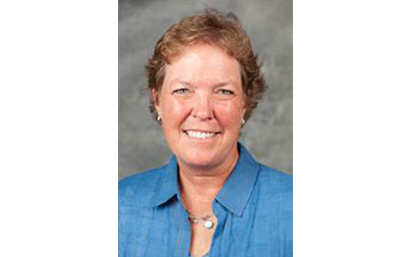
Troxel named director of Center for Excellence and Research
Wendy Troxel joined the faculty last month as the inaugural director of the Center for Excellence and Research in Academic Advising and Student Success.
Troxel joined NACADA: The Global Community for Academic Advising staff in June and has a faculty position in the College of Education. In her previous position, she served as an associate professor in the Department of Educational Administration and Foundations at Illinois State University, where she focused on research methods, program evaluation and assessment at the graduate level. Prior to that appointment, Troxel served as interim department chair and director of the University Assessment Office at Illinois State, as well as director for research and assessment in the Division of Student Affairs at the University of Alabama at Birmingham, where she earned a doctorate in educational leadership.
A NACADA member, Troxel is the incoming co-editor of the NACADA Journal, a research committee member and past chair of the research committee.
“We are elated that Dr. Troxel joined the association as research center director,” said Charlie Nutt, executive director of NACADA. “She has been an active and committed member of the association for years, and we are delighted that her many talents and expertise will now be a global asset.”
The Center for Excellence and Research in Academic Advising and Student Success will unite theorists, scholars and practitioners seeking to advance scholarly practice and applied research related to academic advising. The center is expected to be in full operation in early 2017, partnering with relevant entities and organizations, promoting research-based practices in academic advising, and securing funding and professional development opportunities related to academic advising research. Because academic advising is so closely partnered with student success, the center will examine a broad range of issues.
College of Engineering
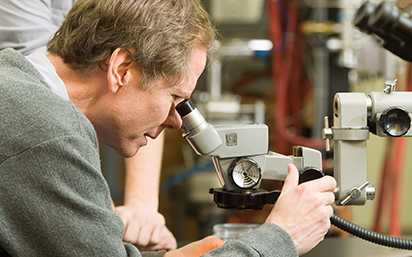
Patented process builds better semiconductors, improves electronic devices
Through a surprise research discovery, a Kansas State University chemical engineer has found the icing on the cake for electronic devices.
Jim Edgar, university distinguished professor of chemical engineering, has received a patent for his invention “Off-axis silicon carbide substrates,” which is a process for building better semiconductors.
The research may help improve electronic devices and could benefit the power electronics industry and manufacturers of semiconductor devices.
Electronics are made of semiconducting crystals that must be layered perfectly for the electronic device to work.
“It’s like a stacked cake separated by layers of icing,” Edgar said. “When the layers of semiconductors don’t match up very well, it introduces defects. Any time there is a defect, it degrades the efficiency of the device.”
Edgar’s research has developed a better way to build semiconductors and layer them to minimize potential defects — an important discovery for manufacturers.
Edgar describes the research discovery as serendipitous. Several years ago, when Yi Zhang, a 2011 doctoral graduate in chemical engineering, was working in the laboratory, she found a substrate sample that was very smooth.
Collaborative researchers at the State University of New York at Stony Brook and the University of Bristol in the United Kingdom later confirmed the layer’s presence and proved it had fewer defects than on the standard substrate.
“We have applied this process to other systems,” Edgar said. “We are working on verifying that it is not just these specific materials we started with, but that it can be applied to a lot of different materials.”
Some of Edgar’s latest research focuses on two different boron compounds: boron phosphide and icosahedral phosphide.
The researchers received support from the National Science Foundation.
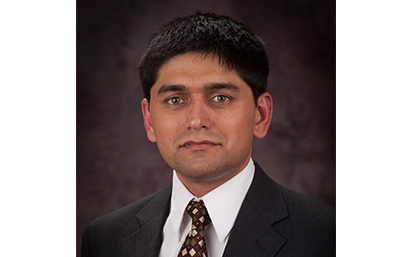
Engineer receives award for nanotechnology research, educational outreach
A prestigious award will support a Kansas State University engineer’s research on nanosheets and will help organize educational activities for high school students and teachers.
Gurpreet Singh, associate professor of mechanical and nuclear engineering, has received a $500,000 National Science Foundation CAREER award, “Scalable liquid exfoliation processing of ultrathin two-dimensional metal dichalcogenides nanosheets for energy storage devices.”
Singh will use the award to develop ultrathin metal sheets that can help produce better rechargeable batteries, supercapacitors and catalysts for photoelectrochemical hydrogen production.
The award will help with more than research — Singh also will organize hands-on educational activities. He is planning nanotechnology-oriented summer workshops for high school science teachers and female high school students.
“I want to create excitement about the opportunities in nanotechnology and also make others aware of the challenges related to scalable manufacture and high-cost that is currently hindering introduction in practical applications,” Singh said.
The National Science Foundation’s Faculty Early Career Development Program is one of the foundation’s most prestigious awards for supporting early career faculty who effectively integrate research and education within the context of their institution’s mission. Faculty recognition and awards are an important part of K-State’s plan to become a Top 50 public research university by 2025.
With his CAREER award, Singh will study large-scale production of ultrathin sheets — a few atoms thick and several micrometers wide — of transition metal dichalcogenides, or TMDs. Nearly 40 types of TMDs have been identified, including naturally occurring molybdenite.
Little is known about the structure of TMDs and their mechanical, electrical and electrochemical properties, Singh said.
Some of TMDs’ physical and chemical properties can address energy-related concerns. For these TMDs to improve technology, they must be produced in ultrathin sheets, Singh said. Bulk quantities of nanosheets are necessary for energy applications, including rechargeable batteries, supercapacitors and catalysts for photoelectrochemical hydrogen production.
No current method is available to cost-effectively produce atomically thin TMDs in large quantities, Singh said. His research aims to make that possible.
“For long-term sustainability it is important to look at alternative energy production routes as well as methods for efficient energy storage and distribution,” Singh said. “This requires exploration into new materials and designs that can offer superior performance with improved efficiency and at a fraction of the cost.”
Some of Singh’s other research has focused on using graphene oxide to improve sodium- and lithium-ion flexible batteries and creating carbon nanotubes for better laser detectors and rechargeable batteries.
College of Human Ecology
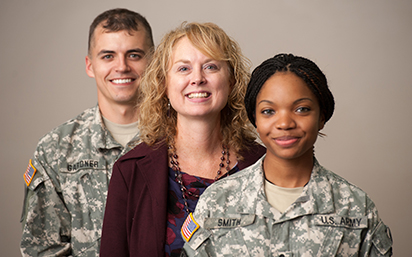
‘Bridging the Gap’: Taking action to help veterans with post-traumatic stress disorder
As our military troops are deployed into war zones and unsettled areas, more soldiers are returning home and facing the challenges that occur with post-traumatic stress disorder, or PTSD. There are days and months set aside to acknowledge and bring awareness to PTSD, but a Kansas State University institute is offering more.
K-State and Fort Riley are interconnected and supportive of one another, and it is important to note Fort Riley is currently in a cycle of units preparing to deploy. To improve the well-being of military families, Briana Nelson Goff ’91, ’93, director of the Institute for the Health and Security of Military Families, has created a team that offers retreats for post-9/11 service members and veterans dealing with PTSD.
With the institute, part of the School of Family Studies and Human Services in the College of Human Ecology at K-State, Goff is using combined knowledge and resources to better equip our veterans with the tools needed to help their PTSD symptoms and relationships. Those with PTSD do not suffer alone, and their family and friends can encourage and support any treatment or coping method.
Partnering with the institute are Victoria Bruner, clinical director of the retreats and program expert formerly with the Defense Centers of Excellence for Psychological Health and Traumatic Brain Injury, Walter Reed National Military Medical Center; Adrian and Diana Veseth-Nelson, co-founders of Invisible Wound, a veteran’s service organization that helps veterans manage their post-traumatic stress disorder; and Joshua’s Hands, an organization dedicated to service with an outreach component that provides quilts for wounded warriors.
Additionally, Kali Summers ’13, ’15, executive officer of the institute under Goff, serves as the retreat’s director of operations. Together, these entities develop, organize and host periodic regional retreats for veterans and a primary support person, who attends the retreats with the veterans. In 2015, they received funding from the Walter Reed Society, which has allowed them to expand the program.
“The support from the Walter Reed Society has allowed this program to reach even more veterans dealing with PTSD,” said Goff, who also is in charge of conducting the research for the program.
Currently, Goff’s team is analyzing pre-, post- and follow-up data from 11 retreats since 2013. Goff and her team also are collecting salivary cortisol data during the retreats to look at biometric indicators of stress in the participants.
“Participants report a reduction in post-traumatic stress symptoms and better relationship quality over the four days. We are adding the biomarker data to determine whether there are any physiological changes over the course of their participation in the retreat,” said Goff.
These retreats are named “Bridging the Gap” due to the chasm that can open up between soldiers returning from deployments and their loved ones and communities. For each retreat, 10-12 pairs are selected, and veterans can choose to participate with any type of support person — spouse, sibling, parent or friend. They have to fill out an application and are chosen by the clinical director, Bruner, who also facilitates the four day retreats.
During the retreats, pairs receive psychological education about PTSD and are introduced to a variety of coping methods, such as yoga, art therapy, meditation, equine and canine therapies, and other complementary and alternative modalities. Sleep issues are addressed as a common companion to PTSD since the veterans have often been on alert for an entire deployment. Returning to civilian life doesn't always restore positive sleep cycles, and getting sleep — enough and good quality — is essential to good health.
A unique aspect of the Bridging the Gap retreats is that an experienced peer mentor pair attends each retreat with new participants. This mentor couple can speak to the complexities of PTSD as a veteran and as a support person who is involved in taking care of a loved one who is experiencing PTSD every day. They also have attended a previous retreat together and can speak to the sessions and challenges that the pairs face. The Veseth-Nelsons served as peer mentors for previous retreats. Read about their in-depth experience in Stars and Stripes.
The current team has been involved with developing the retreats program since 2011. The first Bridging the Gap retreat funded by the Walter Reed Society was in Washington, D.C., in December 2015, with a second in Chicago, Illinois, in March 2016, and a third in Manhattan, Kansas, in August 2016. The Walter Reed Society funding has allowed the program to rotate the areas where the retreats are organized to be accessible to veterans all over the nation. More retreats are in the planning stages for 2017, and organizers would like to explore retreats that would incorporate entire families and children, as well as groups from individual military units.
For additional information about the Bridging the Gap retreats, please contact Briana Nelson Goff at bnelson@k-state.edu.
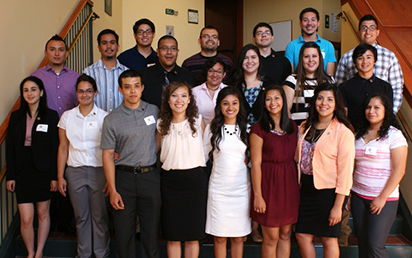
Southwest Kansas community college students offered path to bachelor’s degree with Bridges to the Future grant
A new five-year, $1.3 million Bridges to the Future grant from the National Institutes of Health will help students at community colleges in southwest Kansas continue to earn bachelor’s degrees at Kansas State University.
The purpose of the Bridges to the Future grant is to increase the number of underrepresented students with baccalaureate degrees in the biomedical and behavioral sciences and to set into motion pathways designed to increase the number of graduate and medical degrees in those fields, said John Buckwalter, dean of the university’s College of Human Ecology, which is overseeing the grant.
“The grant makes possible critical resources that can provide a successful path for Bridges students to begin their postsecondary pursuits at Dodge City Community College, Garden City Community College and Seward County Community College in Liberal for two years, followed by matriculation to Kansas State University,” Buckwalter said.
Community college partners in the Bridges to the Future project are Elizabeth Wallace, professor of chemistry at Dodge City Community College; Stephen Wuerz, instructor of science at Garden City Community College; and Myron Perry, instructor of microbiology at Seward County Community College. K-State’s Buckwalter; Charlotte Shoup Olsen ’69, ’79, ’93, professor and extension specialist in the School of Family Studies and Human Services; and Anita Cortez ’83, director of the Office of Undergraduate Research and Creative Inquiry, collaborated with the community colleges to continue this highly successful program.
“This project identifies promising students at the community college level and provides them with opportunities to be successful in the behavioral and biomedical fields, while also serving as an excellent outreach opportunity for connecting with underrepresented populations within the state of Kansas,” Olsen said.
The Bridges program supports students by building relationships with them and their families while at the community colleges. The students and families are then invited to visit K-State, where they can become familiar with the larger campus, support staff and students who have matriculated through the program.
“Participants in Bridges to the Future can join an established, highly successful, undergraduate research program, Developing Scholars,” Cortez said. “The Developing Scholars Program supports students academically and personally through providing seminars, workshops, lab experiences and research internships to help students explore their options in biomedical and behavioral sciences. Through the Bridges program, students are prepared to succeed in graduate school and establish thriving professional careers.”
While this is a new grant, K-State has sponsored 104 students through past NIH Bridge grants. Three-quarters of those students have already graduated with others still on the path. Of those students who have earned bachelor degrees, nearly 40 percent have pursued professional or graduate programs. Some of these students have gone to medical school, optometry school, chiropractic school, dental school and veterinary college. Others have taken their academics to the national arena and earned a highly competitive National Science Foundation Fellowship, a Goldwater Scholarship, a Phi Kappa Phi Graduate Fellowship and an internship in a Harvard lab.
“Bridges to the Future has an 11-year history here at K-State and provides a well-established pathway for students transferring from southwestern Kansas to K-State’s Developing Scholars Program,” Cortez said. “We have established long-standing relationships with families in the Liberal, Garden City and Dodge City areas, so when they attend the annual Developing Scholars Research Symposium in the spring, it is a celebratory reunion. We know that families, students and staff, both at the community colleges and at K-State, have all worked hard to make Bridges to the Future the success that it is.”
College of Technology and Aviation
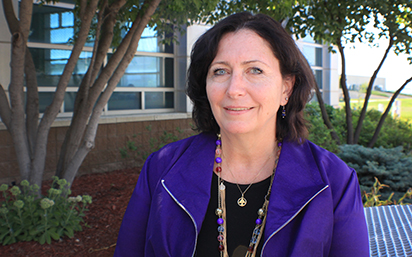
Dean Verna Fitzsimmons receives national recognition with Inspiring Women in STEM Award
As the first woman to be dean and CEO of Kansas State University’s Polytechnic Campus, Verna Fitzsimmons is receiving national recognition for her continued support and leadership of women in the fields of science, technology, engineering and mathematics, or STEM.
INSIGHT Into Diversity magazine, the largest and oldest diversity and inclusion publication in higher education, has named Fitzsimmons a recipient of their 2016 Inspiring Women in STEM Award. This accomplishment honors women who work to inspire and encourage a new generation of young women to consider careers in STEM through mentoring, teaching, research and successful programs and initiatives. Fitzsimmons will be featured, along with 65 other recipients, in the September 2016 issue of the magazine.
“I am truly honored to receive this recognition because part of my purpose as a female educator with an engineering background is instilling in young women the belief that there are no boundaries when it comes to their future,” said Fitzsimmons, who has been at the helm of Kansas State Polytechnic since 2012. “Growing up, I had amazing mentors who encouraged and exposed me to STEM fields and I believe it is my responsibility as well as my honor to do the same for the next generation.”
Fitzsimmons, who holds a bachelor’s, master’s and doctoral degree in industrial engineering — all from the University of Cincinnati — was selected for the honor because of the example she sets for other female faculty, staff and students on campus as well as her community involvement and commitment to providing campus programs that empower young girls. Under Fitzsimmons’ leadership, the campus’s professional education and outreach department has grown attendance to its annual Teen Women in Science and Technology conference offered to Kansas high schools and has become an official member of the Girl Scouts’ Program on Demand initiative, which focuses on providing STEM learning experiences.
“We know women in STEM fields are not always represented or recognized for their success, dedication and mentorship to others,” said Lenore Pearlstein, owner and publisher of INSIGHT Into Diversity magazine. “We want to honor those who are inspirations to their colleagues, their community and to young girls everywhere who may be interested in a future career in STEM. We are proud to honor these women as role models to all.”
Prior to joining Kansas State Polytechnic, Fitzsimmons was an associate professor in the College of Applied Engineering, Sustainability and Technology at Kent State University. She served as the college’s interim dean from 2008-2010, successfully leading it through the transition to applied engineering and a responsibility-centered management funding model.
Along with serving at Kent State University, Fitzsimmons’ background in academia includes teaching at Milwaukee School of Engineering, Wright State University Lake Campus, Case Western Reserve University and Cleveland State University. She has a vast background in industry as well, including General Electric Health Care, and experience as a resource management, safety and regulatory engineer and an international liaison engineer.
Inspiring Women in STEM Award recipients were nominated by colleagues after a call for award submissions was announced in January 2016. For more information about the 2016 Inspiring Women in STEM Award and INSIGHT Into Diversity magazine, visit insightintodiversity.com. For more information about Kansas State Polytechnic, visit the campus’s website at polytechnic.k-state.edu.

Tim Bower’s robotics education article published in prestigious engineering magazine
Tim Bower ’87, a computer systems technology professor at Kansas State University’s Polytechnic Campus, is being recognized for his teaching methods in robotics programming by the Institute of Electrical and Electronics Engineers, or IEEE.
Bower composed an article in April last year about his strategies for educating beginning students on the complexities of robotics, and it was chosen by IEEE Robotics and Automation magazine for publication in the June 2016 edition. The story, entitled “Teaching Introductory Robotics Programming,” was one of only nine editorials selected out of almost 40 submissions from 15 different countries.
The article is inspired by the robotics programming course Bower created in spring 2014. With a variety of majors enrolled, including unmanned aircraft systems, mechanical engineering technology and electronic and computer engineering technology, he knew many of the students would only have basic knowledge of the technology and may have challenges comprehending the algorithms involved. Bower streamlined the course by highlighting the areas of robotics that are more understandable for beginners and in one case, developed his own algorithm.
“In robotics programming, multiple things are happening at the same time — reading sensors, controlling wheels and motors, steering — and it can be a difficult technology to master,” said Bower, who has been with Kansas State Polytechnic for 12 years. “As a professor, the last thing I want is to frustrate and discourage students by forcing them to learn something that isn’t on their educational level. It’s important to create a path where students have an appreciation for the complexities and also leave my class feeling successful.”
Bower’s article, which gives examples of the simplified autonomous algorithms he uses in the course including the wall-following algorithm he invented, was chosen for publication because of the quality of the written document as well as its purpose of helping beginners feel comfortable with robotic programming. This is Bower’s first article that a publication of IEEE has picked up, though he has had a few previous articles appear in other educational journals.
“I’m very honored to see my article selected for such a prestigious publication — it’s a validating feeling when my many hours of research and teaching are recognized,” Bower said. “Most importantly, however, I hope it gives teachers and professors ideas and strategies they can use to help their students feel more confident and accomplished.”
Before arriving on the Kansas State Polytechnic campus in 2004, Bower was a systems administrator in the computer science department on K-State’s Manhattan campus. He also worked for 10 years at Sprint in Kansas City as an electrical engineer. Bower earned a bachelor’s degree in electrical engineering from K-State and a master’s in electrical engineering from the University of Kansas.
In 2015, Bower won Kansas State Polytechnic’s Excellence in Innovation Award during the campus Faculty and Professional Staff Awards Showcase.
College of Veterinary Medicine
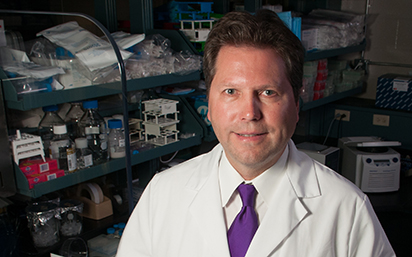
CEEZAD receives $2.3 million grant for vaccine research
The Center of Excellence for Emerging Zoonotic and Animal Diseases (CEEZAD) at Kansas State University recently received a $2.3 million grant from the Defense Threat Reduction Agency (DTRA) to conduct research on the safety in livestock of a newly developed vaccine to protect humans against infection with the Ebola Zaire virus. DTRA is an agency within the U.S. Department of Defense.
The grant, from DTRA in collaboration with the commercial firm NewLink Genetics, includes a $100,000 matching contribution from the state of Kansas’ NBAF Transition Funds. K-State researchers will study the safety of the vaccine in swine, cattle and horses in K-State’s Biosecurity Research Institute.
The vaccine is called “VSV-ZEBOV,” an acronym for vesicular stomatitis virus, a virus with particular importance to farmers since it can infect cattle and its clinical presentation is identical to the foot and mouth disease virus, and the Zaire strain of Ebola virus, the main strain that causes the severe, often fatal, Ebola hemorrhagic fever disease in humans. The virus is thought to be transmitted to people from an as-yet unidentified wild animal reservoir, and then spreads in the human population through human-to-human transmission. The average disease case fatality rate is around 50 percent, but has varied from 25 percent to 90 percent in various outbreaks.
Dr. Jürgen A. Richt, Regents Distinguished Professor, will be the principal investigator for the project. The live, recombinant vaccine consists of an attenuated Indiana strain of VSV, wherein the surface glycoprotein component of VSV has been replaced with the Ebola virus glycoprotein component in order to induce protective immunity against the Ebola Zaire virus.
“We are very excited to begin research to test the safety of this vaccine, the only efficacious Ebola virus vaccine yet, for safety in livestock at KSU,” Richt said. “As the world saw with the deadly 2014 outbreak in West Africa, Ebola is one of the most serious emerging zoonotic threats to humans.” Richt took particular note of “the generous contribution of $100,000 from the NBAF Transition Funds” toward the study.
Zoonotic diseases are those capable of being transmitted from animals to humans and vice-versa. It is thought the Ebola virus, which was first identified in 1976, is introduced into the human population through close contact with infected animals such as chimpanzees, gorillas, bats, monkeys and maybe antelope and porcupines. It is also possible the Ebola virus can be transmitted through sexual contact involving already-infected persons. The Zaire species of Ebola virus is one of five species that have been identified, and has been associated with large disease outbreaks in Africa — including the 2014 West African outbreak which infected an estimated 28,600 people and resulted in more than 11,000 deaths.
At K-State, researchers will test the safety of the vaccine in swine, cattle and horses, while it needs to be noted no infectious Ebola virus will be used during these studies. The work will provide information to supplement the overall safety of the VSV-ZEBOV vaccine.
CEEZAD is a U.S. Department of Homeland Security Center of Excellence established in 2010 at the Kansas State University College of Veterinary Medicine.
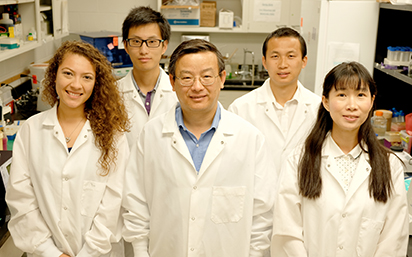
Researcher receives grant for vaccine development against E. coli-associated diarrhea
Weiping Zhang, professor of microbiology in the College of Veterinary Medicine at Kansas State University, was recently awarded a $2.1 million National Institutes of Health R01 grant for the next five years. The grant will support the development of a vaccine to guard against E. coli-associated diarrhea. NIH has awarded two additional grants to Zhang in the last three years to develop vaccines against E. coli diarrhea.
“Diarrhea continues to be a leading cause of death in children under five years of age, and enterotoxigenic E. coli (ETEC) is the most common bacterial cause of children's diarrhea,” Zhang said. “Currently, there are no available vaccines against ETEC-associated diarrhea. Whole-cell vaccine candidates have been under development, but require further improvements because they provide inadequate protection and produce unwanted adverse effects.”
“Effective vaccines for ETEC have proved to be very challenging,” said Frank Blecha, associate dean for research in the veterinary college. “Dr. Zhang’s vaccine development strategy for ETEC using multiepitope fusion antigens holds great promise for a vaccine that will limit diarrheal deaths in humans and animals.”
Zhang was trained as a molecular evolutionary biologist and his E. coli pathogenesis and vaccine research and development career began in 2003 when he studied molecular pathogenesis of individual enterotoxins produced by ETEC in diarrheal disease in swine.
“Our work has focused most recently on multiepitope fusion antigens (MEFA) for the development of broadly protective ETEC vaccines,” Zhang said. “Different ETEC strains produce immunologically heterogeneous bacterial adhesins to attach host cells and colonize in small intestines, initiating ETEC diarrheal disease. With the inclusion of another adhesin multiepitope fusion antigen, then a subunit vaccine is potentially able to induce antibodies against both toxins and up to 15 prevalent ETEC adhesins, thus effectively protecting against ETEC diarrhea. This grant will allow us to continue our research and study the effectiveness of this approach.”
“Grants are critical for providing the resources needed for advancing research and promoting good science,” said M.M. Chengappa, university distinguished professor and head of diagnostic medicine/pathobiology. “The work being conducted by Dr. Zhang has significance for both human and animal health. This grant also recognizes the quality of Dr. Zhang’s work, which we truly value in our department and college.”
Zhang said his MEFA technology has attracted attention from funding agencies, including the Bill and Melinda Gates Foundation, and was featured in a recent Vaccines against Shigella and ETEC (VASE) meeting in Washington, D.C. Zhang’s laboratory currently is also working on ETEC vaccine projects funded by PATH Vaccine Solution/Bill and Melinda Gates Foundation.
